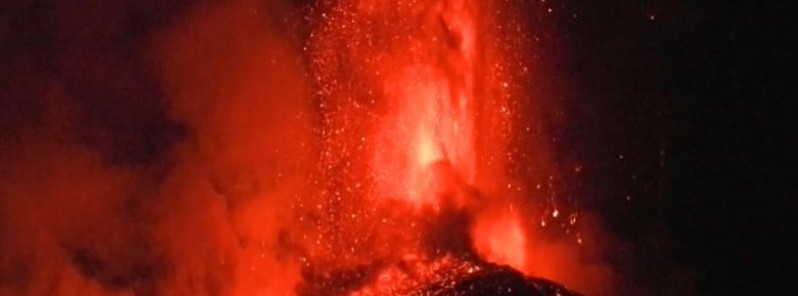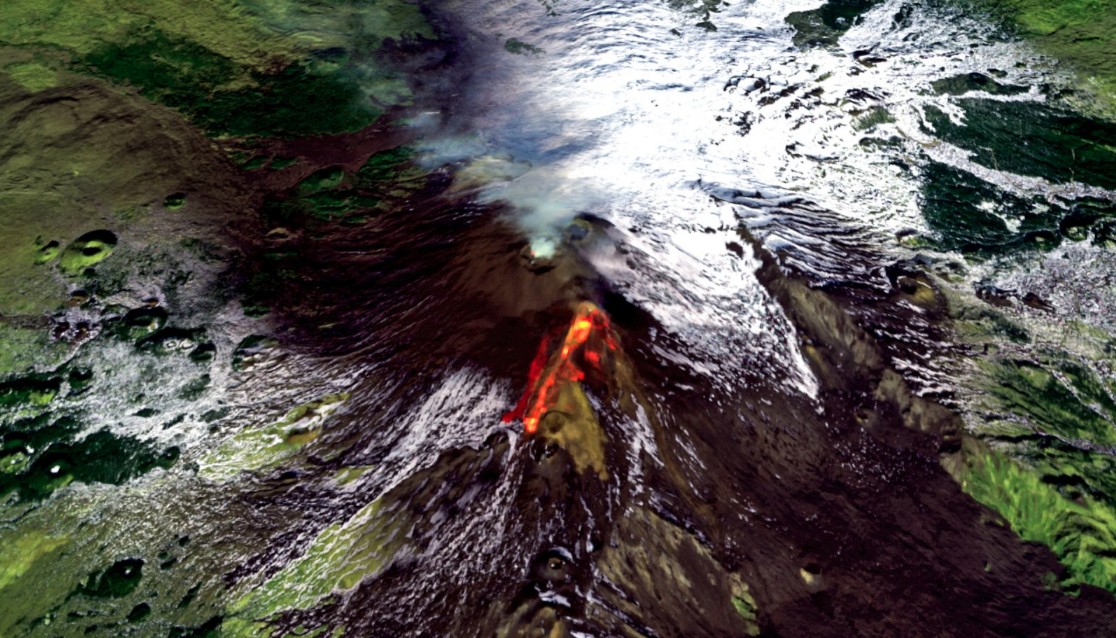Powerful eruption at Etna volcano, heavy ash emissions to 10 km (32 800 feet) a.s.l., Italy

Strombolian activity at Etna's Southeast Crater resumed early February 10, 2022, and reached full paroxysmal phase by the end of the day, with lava fountains 500 – 600 m (1 600 – 2 000 feet) tall, lava flows to southwest and southeast, and eruptive column up to 10 km (32 800 feet) above sea level. The Aviation Color Code was raised from Yellow to Orange at 04:16 and to Red at 18:59 UTC.
Volcanic tremor reached moderate levels at 01:30 UTC and continued with a growing trend. The source was located under Southeast Crater at a depth of approximately 3 km (1.8 miles) above sea level. Infrasonic activity localized at Southeast Crater also saw an increase at the time, INGV-OE reported.1
The tremor reached elevated levels around 13:30 UTC, followed by moderately long lava flows to the SW and W at 14:20 UTC.
Strombolian activity increased notably at around 16:00 UTC, with lava flows reaching an estimated altitude of approximately 2.9 km (1.8 miles) a.s.l.
While Etna is not famous for producing pyroclastic flow, three streams were recorded yesterday — at 20:40, 21:19 and 21:26 UTC. The first two streams traveled a few hundred meters toward Valle del Bove while the third headed toward the south, also for a few hundred meters.



Etna on February 11, 2022. Credit: Copernicus EU/Sentinel-2, Antonio Vecoli, TW
Lava fountaining — the first paroxysmal eruptive episode of the year — started at around 20:40 and lasted until 23:19 UTC, with strong ash emissions to 10 km (32 000 feet) a.s.l. at the top, drifting W.
COMUNICATO DI ATTIVITA' VULCANICA del 2022-02-10 18:52:16(UTC) – ETNA.
L'Istituto Nazionale di Geofisica e Vulcanologia, OE, comunica che dalle 16:00 UTC circa si è assistito ad una intensificazione dell'attività stromboliana al Cratere di Sud Est.https://t.co/tJmhC0MNDm pic.twitter.com/FvCJ9vFAuu— INGVvulcani (@INGVvulcani) February 10, 2022
#Etna. Con L'eruzione di stasera, questo #vulcano ci ha stupito ancora una volta. Fulmini (effetto triboelettrico ) ed immense fontane di lava #sicilia #landscapephotography #nature #NaturePhotography #photography #SonyAlpha pic.twitter.com/PKO1ztDRR3
— Emilio (VJ KAR) (@VjKar) February 10, 2022
COMUNICATO DI ATTIVITA' VULCANICA del 2022-02-10 20:51:44(UTC) – ETNA.
L'Istituto Nazionale di Geofisica e Vulcanologia,-OE, comunica che a partire dalle 20:40 UTC circa si osserva una fontana di lava al Cratere di Sud-Est.
qui le immagini live:https://t.co/EpxE0DVzB7 pic.twitter.com/U7GVAe4jrP— INGVvulcani (@INGVvulcani) February 10, 2022
COMUNICATO DI ATTIVITA' VULCANICA del 2022-02-10 21:39:23(UTC) – ETNA.
L'Istituto Nazionale di Geofisica e Vulcanologia, OE, comunica che si sono verificati tre flussi di materiale piroclastico dal Cratere di Sud Est.https://t.co/tJmhC0MNDm pic.twitter.com/DSgkhvrR0V— INGVvulcani (@INGVvulcani) February 10, 2022
COMUNICATO DI ATTIVITA' VULCANICA del 2022-02-10 23:18:13(UTC) – ETNA.
L'Istituto Nazionale di Geofisica e Vulcanologia, OE, comunica che la fontana di lava al Cratere di Sud-Est è cessata.https://t.co/tJmhC0MNDm pic.twitter.com/Pkp8UpHptT— INGVvulcani (@INGVvulcani) February 10, 2022
Geological summary
Mount Etna, towering above Catania, Sicily's second-largest city, has one of the world's longest documented records of historical volcanism, dating back to 1500 BCE.
Historical lava flows of basaltic composition cover much of the surface of this massive volcano, whose edifice is the highest and most voluminous in Italy.
The Mongibello stratovolcano, truncated by several small calderas, was constructed during the late Pleistocene and Holocene over an older shield volcano. The most prominent morphological feature of Etna is the Valle del Bove, a 5 x 10 km (5.1 x 6.2 miles) horseshoe-shaped caldera open to the east.
Two styles of eruptive activity typically occur at Etna. Persistent explosive eruptions, sometimes with minor lava emissions, take place from one or more of the three prominent summit craters, the Central Crater, NE Crater, and SE Crater (the latter formed in 1978).
Flank vents, typically with higher effusion rates, are less frequently active and originate from fissures that open progressively downward from near the summit (usually accompanied by strombolian eruptions at the upper end).
Cinder cones are commonly constructed over the vents of lower-flank lava flows. Lava flows extend to the foot of the volcano on all sides and have reached the sea over a broad area on the SE flank.2
References:
1 Communicate attivita vulcanica – INGV-OE – February 10, 2022
2 Etna – Geological summary – GVP
Featured image credit: INGV/Boris Behncke

Commenting rules and guidelines
We value the thoughts and opinions of our readers and welcome healthy discussions on our website. In order to maintain a respectful and positive community, we ask that all commenters follow these rules:
We reserve the right to remove any comments that violate these rules. By commenting on our website, you agree to abide by these guidelines. Thank you for helping to create a positive and welcoming environment for all.